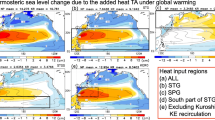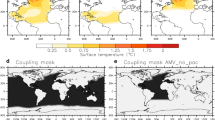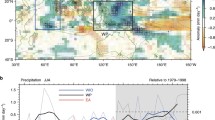Abstract
The relative roles of the oceanic and atmospheric processes in the pattern formation of the equatorial Pacific sea surface temperature (SST) response to global warming is investigated using a set of climate model experiments embedded with a novel partial coupling technique. The modeling results show that the SST response experiences a transition from a La Niña-like warming pattern at the initial stage to an El Niño-like warming pattern at the quasi-equilibrium stage. By decomposing anomalous equatorial Pacific SST into atmosphere thermally forced passive component and ocean dynamically induced active component, it is found that the SST warming pattern at both stages is entirely induced by its active component. Specifically, the meridional and vertical ocean circulation changes play a dominant role in forming the La Niña-like SST warming pattern at the initial stage, and the zonal and meridional ocean circulation changes are responsible for the formation of the El Niño-like SST warming pattern at the quasi-equilibrium stage. In contrast, the passive SST at both stages is characterized by a zonally uniform warming along the equator, which can be explained by a balance between the total effect of the heat transport divergence associated with the mean ocean circulation and the effect of the passive surface heat flux change. In addition, this study finds that it is the slowdown of the Pacific subtropical cells during the transition period that controls the evolution of the equatorial SST warming pattern by changing the meridional and vertical ocean heat transports.











Similar content being viewed by others
Data availability
The CESM data used in this study are available from the corresponding author upon request.
References
An S-I, Im S-H (2014) Blunt ocean dynamical thermostat in response of tropical eastern Pacific SST to global warming. Theor Appl Climatol 118:173–183
Banks HT, Gregory JM (2006) Mechanisms of ocean heat uptake in a coupled climate model and the implications for tracer based predictions of ocean heat uptake. Geophys Res Lett 33:L07608. https://doi.org/10.1029/2005GL025352
Bordbar MH, Martin T, Latif M, Park W (2017) Role of internal variability in recent decadal to multidecadal tropical Pacific climate changes. Geophys Res Lett 44:4246–4255
Burls NJ, Muir L, Vincent EM, Fedorov A (2017) Extra-tropical origin of equatorial Pacific cold bias in climate models with links to cloud albedo. Clim Dyn 49:2093–2113
Cai W, Wu L, Lengaigne M, Li T, McGregor S, Kug JS et al (2019) Pantropical climate interactions. Science 363:eaav4236
Cane MA, Clement AC, Kaplan A, Kushnir Y, Pozdnyakov D, Seager R, Zebiak S, Murtugudde R (1997) Twentieth century sea surface temperature trends. Science 275:957–960
Clement AC, Seager R, Cane MA, Zebiak SE (1996) An ocean dynamical thermostat. J Clim 9:2190–2196
Coats S, Karnauskas KB (2017) Are simulated and observed twentieth century tropical Pacific sea surface temperature trends significant relative to internal variability? Geophys Res Lett 44:9928–9937
Collins M (2005) El Niño- or La Niña-like climate change? Clim Dyn 24:89–104
Collins M, An S-I, Cai W, Ganachaud A, Guilyardi E, Jin F-F, Jochum M, Lengaigne M, Power S, Timmermann A (2010) The impact of global warming on the tropical Pacific Ocean and El Niño. Nat Geosci 3:391–397
DiNezio PN, Clement AC, Vecchi GA, Soden BJ, Kirtman BP, Lee S-K (2009) Climate response of the equatorial Pacific to global warming. J Clim 22:4873–4892
DiNezio PN, Kirtman BP, Clement AC, Lee S-K, Vecchi GA, Wittenberg A (2012) Mean climate controls on the simulated response of ENSO to increasing greenhouse gases. J Clim 25:7399–7420
DiNezio PN, Vecchi GA, Clement AC (2013) Detectability of changes in the Walker circulation in response to global warming. J Clim 26:4038–4048
Du Y, Xie S-P (2008) Role of atmospheric adjustments in the tropical Indian Ocean warming during the 20th century in climate models. Geophys Res Lett 35:L08712
England MH, McGregor S, Spence P, Meehl GA, Timmermann A, Cai W, Gupta AS, McPhaden MJ, Purich A, Santoso A (2014) Recent intensification of wind-driven circulation in the Pacific and the ongoing warming hiatus. Nat Clim Change 4:222–227
Fang C, Wu L (2008) The role of ocean dynamics in tropical Pacific SST response to warm climate in a fully coupled GCM. Geophys Res Lett 35:L08703. https://doi.org/10.1029/2007GL033097
Fedorov AV, Philander SG (2000) Is El Niño changing? Science 288:1997–2002
Fosu B, He J, Liguori G (2020) Equatorial pacific warming attenuated by SST warming patterns in the tropical Atlantic and Indian oceans. Geophys Res Lett 47:e2020GL088231
Garuba OA, Rasch PJ (2020) A partial coupling method to isolate the roles of the atmosphere and ocean in coupled climate simulations. J Adv Model Earth Syst 12:e2019MS002016. https://doi.org/10.1029/2019MS002016
Garuba OA, Lu J, Liu F, Singh HA (2018a) The active role of the ocean in the temporal evolution of climate sensitivity. Geophys Res Lett 45:306–315
Garuba OA, Lu J, Singh HA, Liu F, Rasch P (2018b) On the relative roles of the atmosphere and ocean in the Atlantic multidecadal variability. Geophys Res Lett 45:9186–9196
Gu D, Philander SGH (1997) Interdecadal climate fluctuations that depend on exchanges between the tropics and extratropics. Science 275:805–807
Haney RL (1971) Surface thermal boundary condition for ocean circulation models. J Phys Oceanogr 1:241–248
He C, Clement AC, Cane MA, Murphy LN, Klavans JM, Fenske TM (2022) A North Atlantic warming hole without ocean circulation. Geophys Res Lett 49:1–11
Heede UK, Fedorov AV (2021) Eastern equatorial Pacific warming delayed by aerosols and thermostat response to CO2 increase. Nat Clim Change 11:696–703
Heede UK, Fedorov AV, Burls NJ (2020) Time scales and mechanisms for the Tropical Pacific response to global warming: a tug of war between the ocean thermostat and weaker Walker. J Clim 33:6101–6118
Heede UK, Fedorov AV, Burls NJ (2021) A stronger versus weaker Walker: understanding model differences in fast and slow tropical Pacific responses to global warming. Clim Dyn 57:2505–2522
Held IM, Soden BJ (2006) Robust responses of the hydrological cycle to global warming. J Clim 19:5686–5699
Hu S, Fedorov AV (2017) The extreme El Niño of 2015–2016 and the end of global warming hiatus. Geophys Res Lett 44:3816–3824
Jin F-F (1996) Tropical ocean–atmosphere interaction, the Pacific cold tongue, and the El Niño-Southern Oscillation. Science 274:76–78
Kleeman R, McCreary JP Jr, Klinger BA (1999) A mechanism for generating ENSO decadal variability. Geophys Res Lett 26:1743–1746
Knutson TR, Manabe S (1995) Time-mean response over the tropical Pacific to increased CO2 in a coupled ocean–atmosphere model. J Clim 8:2181–2199
Kociuba G, Power SB (2015) Inability of CMIP5 models to simulate recent strengthening of the Walker circulation: Implications for projections. J Clim 28:20–35
Kohyama T, Hartmann DL (2017) Nonlinear ENSO warming suppression (NEWS). J Clim 30:4227–4251
Kohyama T, Hartmann DL, Battisti DS (2017) La Niña-like mean-state response to global warming and potential oceanic roles. J Clim 30:4207–4225
Kosaka Y, Xie S-P (2013) Recent global-warming hiatus tied to equatorial Pacific surface cooling. Nature 501:403–407
Li C, Dommenget D, McGregor S (2020) Trans-basin Atlantic-Pacific connections further weakened by common model Pacific mean SST biases. Nat Commun 11:5677
Li Q, Luo Y, Lu J, Liu F (2022) The role of ocean circulation in southern ocean heat uptake, transport and storage response to quadrupled CO2. J Clim 35:3565–3582
Liu Z (1998) The role of ocean in the response of tropical climatology to global warming: the west–east SST contrast. J Clim 11:864–875
Liu Z, Vavrus SJ, He F, Wen N, Zhang Y (2005) Rethinking tropical ocean response to global warming: the enhanced equatorial warming. J Clim 18:4684–4700
Liu F, Luo Y, Lu J, Wan X (2017) Response of the tropical Pacific Ocean to El Niño versus global warming. Clim Dyn 48:935–956
Lu J, Zhao B (2012) The role of oceanic feedback in the climate response to doubling CO2. J Clim 25:7544–7563
Lu J, Chen G, Frierson D (2008) Response of the zonal mean atmospheric circulation to El Nino versus global warming. J Clim 21:5835–5851
Luo Y, Rothstein LM, Zhang R-H, Busalacchi AJ (2005) On the connection between South Pacific subtropical spiciness anomalies and decadal equatorial variability in an ocean general circulation model. J Geophys Res 110:C10002. https://doi.org/10.1029/2004JC002655
Luo Y, Lu J, Liu F, Liu W (2015) Understanding the El Niño-like oceanic response in the tropical Pacific to global warming. Clim Dyn 45:1945–1964
Luo Y, Lu J, Liu F, Garuba O (2017) The role of ocean dynamical thermostat in delaying the El Niño-like response over the equatorial Pacific to climate warming. J Clim 30:2811–2827
Luo JJ, Wang G, Dommenget D (2018) May common model biases reduce CMIP5’s ability to simulate the recent Pacific La Niña-like cooling? Clim Dyn 50:1335–1351
Ma J, Yu J-Y (2014) Linking centennial surface warming patterns in the equatorial Pacific to the relative strengths of the Walker and Hadley circulations. J Atmos Sci 71:3454–3464
McCreary JP Jr, Lu P (1994) Interaction between the subtropical and equatorial ocean circulations: the subtropical cell. J Phys Oceanogr 24:466–497
Meehl GA et al (2007) Global climate projections. Climate change 2007: the physical science basis. Cambridge University Press, Cambridge, pp 747–845
Merlis TM, Schneider T (2011) Changes in zonal surface temperature gradients and walker circulations in a wide range of climates. J Clim 24:4757–4768
Plesca E, Grützun V, Buehler SA (2018) How robust is the weakening of the Pacific Walker circulation in CMIP5 idealized transient climate simulations? J Clim 31:81–97
Rahmstorf S, Willebrand J (1995) The role of temperature feedback in stabilizing the thermohaline circulation. J Phys Oceanogr 25:787–805
Ramanathan V, Collins W (1991) Thermodynamic regulation of ocean warming by cirrus clouds deduced from observations of the 1987 El Niño. Nature 351:27–32
Richter I, Xie S-P (2008) Muted precipitation increase in global warming simulations: a surface evaporation perspective. J Geophys Res 113:D24118. https://doi.org/10.1029/2008JD010561
Rivin I, Tziperman E (1997) Sensitivity of air-sea fluxes to SST perturbations. J Clim 10:2431–2446
Rodgers KB, Blanke B, Madec G, Aumont O, Ciais P, Dutay J-C (2003) Extratropical sources of equatorial Pacific upwelling in an OGCM. Geophys Res Lett 30:1084. https://doi.org/10.1029/2002GL016003
Schneider EK, Fennessy MJ, Kinter JL (2009) A statistical–dynamical estimate of winter ENSO teleconnections in a future climate. Clim Dyn 22:6624–6638
Seager R, Murtugudde R (1997) Ocean dynamics, thermocline adjustment and regulation of tropical SST. J Clim 10:521–534
Seager R, Cane M, Henderson N, Lee D-E, Abernathey R, Zhang H (2019) Strengthening tropical Pacific zonal sea surface temperature gradient consistent with rising greenhouse gases. Nat Clim Change 9:517–522
Seager R, Henderson N, Cane M (2022) Persistent discrepancies between observed and modeled trends in the Tropical Pacific Ocean. J Clim 35:4571–4584
Tang T, Luo JJ, Peng K, Qi L, Tang S (2021) Over-projected Pacific warming and extreme El Niño frequency due to CMIP5 common biases. Natl Sci Rev 8:nwab056. https://doi.org/10.1093/nsr/nwab056
Vecchi GA, Soden BJ (2007) Global warming and the weakening of the tropical circulation. J Clim 20:4316–4340
Vecchi GA, Soden BJ, Wittenberg AT, Held IM, Leetmaa A, Harrison MJ (2006) Weakening of tropical Pacific atmospheric circulation due to anthropogenic forcing. Nature 441:73–76
Vecchi GA, Clement AC, Soden BJ (2008) Examining the tropical Pacific’s response to global warming. Eos Trans Am Geophys Union 89:81–83
Wang C (2006) An overlooked feature of tropical climate: Inter-Pacific-Atlantic variability. Geophys Res Lett 33:L12702
Wang C (2019) Three-ocean interactions and climate variability: a review and perspective. Clim Dyn 53:5119–5136
Xie P, Vallis GK (2012) The passive and active nature of ocean heat uptake in idealized climate change experiments. Clim Dyn 38:667–684
Xie S-P, Deser C, Vecchi GA, Ma J, Teng H, Wittenberg AT (2010) Global warming pattern formation: sea surface temperature and rainfall. J Clim 23:966–986
Yamanaka G, Tsujino H, Nakano H, Hirabara M (2015) Decadal variability of the Pacific subtropical cells and its relevance to the sea surface height in the western tropical Pacific during recent decades. J Geophys Res Oceans 120:201–224
Ying J (2020) Sources of uncertainty in the tropical Pacific warming pattern under global warming projected by coupled ocean-atmosphere models. Springer Theses. https://doi.org/10.1007/978-981-32-9844-6_7
Ying J, Huang P (2016) Cloud-radiation feedback as a leading source of uncertainty in the tropical Pacific SST warming pattern in CMIP5 models. J Clim 29:3867–3881
Ying J, Huang P, Huang R (2016) Evaluating the formation mechanisms of the equatorial Pacific SST warming pattern in CMIP5 models. Adv Atmos Sci 33:433–441
Ying J, Collins M, Cai W, Timmermann A, Huang P, Chen D, Stein K (2022) Emergence of climate change in the tropical Pacific. Nat Clim Change 12:356–364
Zhang L, Han W, Karnauskas KB, Meehl GA, Hu A, Rosenbloom N, Shinoda T (2019) Indian Ocean warming trend reduces Pacific warming response to anthropogenic greenhouse gases: an interbasin thermostat mechanism. Geophys Res Lett 46:10882–10890
Acknowledgements
We thank two anonymous reviewers for their valuable comments that helped improve the manuscript. We also acknowledge Dr. Oluwayemi Garuba for sharing the data of the fully and partially coupled experiments with tracers. This work is supported by the Laoshan Laboratory (No. LSKJ202202401) and the National Natural Science Foundation of China (NSFC; 42230405 and 41976006). This research used resources of the National Energy Research Scientific Computing Center (NERSC), a U.S. Department of Energy Office of Science User Facility located at Lawrence Berkeley National Laboratory, operated under Contract No. DE-AC02-05CH11231 using NERSC award ERCAP0017151. JL is supported by the U.S. Department of Energy Office of Science Biological and Environmental Research as part of the Regional and Global Model Analysis program area. Pacific Northwest National Laboratory is operated for DOE by Battelle Memorial Institute under contract DE-AC05-76RL01830.
Funding
This work is supported by the Laoshan Laboratory (No. LSKJ202202401) and the National Natural Science Foundation of China (NSFC; 42230405 and 41976006). This research used resources of the National Energy Research Scientific Computing Center (NERSC), a U.S. Department of Energy Office of Science User Facility located at Lawrence Berkeley National Laboratory, operated under Contract No. DE-AC02-05CH11231 using NERSC award ERCAP0017151. JL is supported by the U.S. Department of Energy Office of Science Biological and Environmental Research as part of the Regional and Global Model Analysis program area. Pacific Northwest National Laboratory is operated for DOE by Battelle Memorial Institute under contract DE-AC05-76RL01830.
Author information
Authors and Affiliations
Contributions
YL, JL and FL were responsible for design of the research. The first draft of the manuscript was written by QL and all authors commented on previous versions of the manuscript. All authors read and approved the final manuscript.
Corresponding author
Ethics declarations
Conflict of interest
The authors have no relevant financial or non-financial interests to disclose.
Additional information
Publisher's Note
Springer Nature remains neutral with regard to jurisdictional claims in published maps and institutional affiliations.
Appendix: Validation of tracer approach
Appendix: Validation of tracer approach
Two passive tracers mimicking ocean temperature are employed to separate the surface-forced and dynamically induced anomalous ocean temperature components in both the FULL and PARTIAL experiments. To validate the tracer approaches, we compare the results from the tracers with the actual temperature anomalies. The result shows that the sum of the surface-forced and dynamically induced components obtained by the two tracer approaches, agrees well with the total temperature anomaly in both FULL and PARTIAL, validating the effectiveness of the tracer approaches in decomposing the ocean temperature response (Fig. 12).
Changes of SST (°C) in a the total response and b the sum of surface-forced and dynamically induced components in FULL. c, d Are same as a and b but for the PARTIAL. A mean of the last 50 years of each simulation is used for analysis. The resemblance between the sum of tracers and the actual SST response supports the validity of the tracer approach
Rights and permissions
Springer Nature or its licensor (e.g. a society or other partner) holds exclusive rights to this article under a publishing agreement with the author(s) or other rightsholder(s); author self-archiving of the accepted manuscript version of this article is solely governed by the terms of such publishing agreement and applicable law.
About this article
Cite this article
Li, Q., Luo, Y., Lu, J. et al. Revisiting the equatorial Pacific sea surface temperature response to global warming. Clim Dyn 62, 2239–2258 (2024). https://doi.org/10.1007/s00382-023-07019-8
Received:
Accepted:
Published:
Issue Date:
DOI: https://doi.org/10.1007/s00382-023-07019-8





